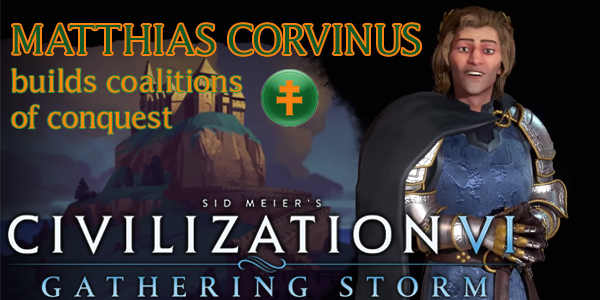
Civilization VI's second expansion, Gathering Storm released earlier this year and has added a handful of new civilizations and leaders. I am hoping to write a strategy for each of them, but I want to start with the civilizations and leaders who are completely new to the franchise. This time, I'll be writing about the last of the truly new civs and leaders: the kingdom of Hungary, lead by the Raven King Matthias Corvinus.
Hungary is a modestly-sized country that lies along the dividing lines between central and eastern Europe, known for its vast geothermal water cave network. It reached its political and military height between the 14th and 15th centuries, when it became a major player in European politics and history. When the Ottomans invaded Europe in the mid-15th century, they set their eyes on securing a valuable border fortress at Belgrade. A noble from Transylvania, named John Hunyadi, levied a mercenary army to defend Belgrade from the Turks and hold back the Ottoman army from successfully gaining a foothold in mainland Europe.

The golden age of the Hungarian Kingdom concluded with the rule of the Raven King Matthias Corvinus, son of John Hunyadi. His election made him the first noble to ascend to the throne without a dynastic background. He was a patron of arts and education, and was seen as a protector of the common folk. His Bibliotheca Corvinian was the second largest library in all of Europe in the 15th century, second only to the Vatican Library. Matthias' mercenary Black Army fought off invasions from the Ottomans (possibly helping to protect all of Europe from Ottoman rule), and also conquered parts of Austria and Bohemia. When Matthias died without an heir, the country fell into decline.
DISCLAIMER:
Civilization VI is still a "living game". Strategies for the game (and for specific leaders and civs) may change as Firaxis applies balance patches, introduces new features, or expands the game through further DLC or expansion packs, or as the Civ community discovers new strategies or exploits. As such, the following strategy guide may change from time to time. I will try to keep it up-to-date, and will make notations whenever changes are made. I'll also post links in the official 2K forums and CivFanatics, where I'll also report any changes made. If possible and practical, I will try to retain the original content of the strategy for posterity.
I welcome any feedback or suggestions that readers wish to offer. Feel free to post on the linked forums, or by posting a comment at the bottom of the page.
This guide is up to date as of the release of the Gathering Storm expansion's "June 2019 update" (ver. 1.0.0.328)
Hungarian cities in Civilization VI do best when founded on snaky rivers and near geothermal fissures. They can be a military force to be reckoned with thanks to a pair of light cavalry unique units and a leader who can use levied city state units to crush his foes.
... [More]
a0bef8e7-e5fc-4a5a-a716-f599f93d6165|2|5.0
Tags:Sid Meier's Civilization, Civilization VI, Civilization VI: Gathering Storm, Hungary, Matthias Corvinus, pearl of the Danube, raven king, thermal bath, huszar, black army, horse, geothermal fissure, river, district, city state, levy
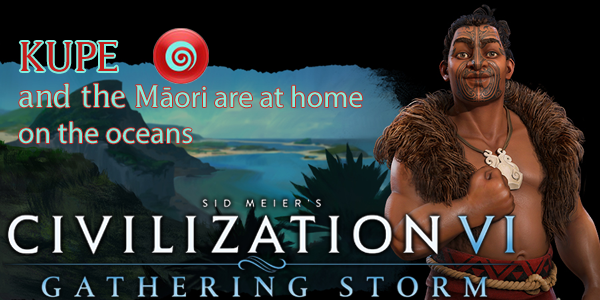
Civilization VI's second expansion, Gathering Storm recently released and has added a handful of new civilizations and leaders. I am hoping to write a strategy for each of them, but I want to start with the civilizations and leaders who are completely new to the franchise. This time, I'll be writing about one of the more interesting of the new civs and leaders: the Māori, lead by Kupe the Navigator.
Natives of the Polynesian Triangle are some of the most successful sea-faring peoples in the history of the world. Between 1400 BC and 900 BC, they had begun sailing large ocean-going craft called "waka", that enabled them to cross from Taiwan, through the Philipines, and out to the Melanesian and Samoan islands. Over the next two thousand years, they managed to colonize Pacific islands as far as Hawai'i, Easter Island, and New Zealand. Some historians even believe that they made it as far as the coast of South America! Sometime in the 13th or 14th century, settlers from Polynesia sailed west, began colonizing New Zealand, conquered the local tribes, and began to culturally diverge from their Polynesian ancestors to become the Māori.
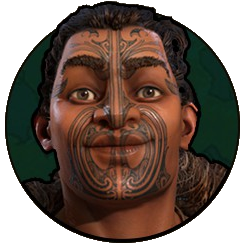
According to legend, the first Polynesian to arrive in New Zealand is Kupe the Navigator, chief of Hawaiki. Kupe is figure in Māori mythology, but like Gilgamesh, Hiawatha, and others, he is believed to be an actual historic figure. Historians have constructed accounts of Kupe's life that differ from the various oral legends of the Maori and Polynesian peoples. According to legends, Kupe sailed from Hawaiki (the mythological birthplace of the Polynesian people), along with great migration fleets, to colonize New Zealand as far back as antiquity, battling sea demons along the way. According to historians, Kupe probably found New Zealand between 750 AD and 925 AD after his cousin drowned on a fishing trip and Kupe fled across the sea with his cousin's kidnapped wife, only to return to Hawaiki later to convince others to migrate to the newly-discovered lands with him.
DISCLAIMER:
Civilization VI is still a "living game". Strategies for the game (and for specific leaders and civs) may change as Firaxis applies balance patches, introduces new features, or expands the game through further DLC or expansion packs, or as the Civ community discovers new strategies or exploits. As such, the following strategy guide may change from time to time. I will try to keep it up-to-date, and will make notations whenever changes are made. I'll also post links in the official 2K forums and CivFanatics, where I'll also report any changes made. If possible and practical, I will try to retain the original content of the strategy for posterity.
I welcome any feedback or suggestions that readers wish to offer. Feel free to post on the linked forums, or by posting a comment at the bottom of the page.
This guide is up to date as of the release of the Gathering Storm expansion's "Great Works and Trade Update" (April 2019) (ver. 1.0.0.317)
Māori are a sea-faring and environmentalist-focused civilization. They can embark and sail across ocean from the beginning of the game, and they get extra yield from unimproved feature tiles. [More]
561fb1a8-9d2a-4002-b81e-1df2c98f29d0|0|.0
Tags:Sid Meier's Civilization, Civilization VI, Civilization VI: Gathering Storm, Maori, Kupe, mana, Kupe's voyage, marae, toa, pa, fort, ocean, embark, forest, rainforest, harvest, resource, unique building, unique melee unit
Last week, just in time for the announcement (and release) of a new expansion for Cities: Skylines, I posted a video analysis on YouTube discussing what I perceive as weaknesses in the modular design philosophy behind Skylines' myriad expansion packs. The full video is available on YouTube (and embedded below), but I've also transcribed the text in blog form for those who may prefer reading over watching/listening.
The video is up on YouTube.
I want to start out by saying that I love Cities: Skylines. Skylines is -- without a doubt in my mind -- the single best city-builder since SimCity 4, which released in 2003 (over 15 years ago, as of the time of this recording). When I watched the first trailer for the game, in which the player apparently custom-builds freeway ramps and interchanges from scratch (at about 40 seconds into the trailer), I was sold on this game! After years of having to use boring, pre-fabricated stock on-ramps and interchanges, the little civil engineer withing me practically jizzed in his pants at the idea of being able to build my own highway ramps and interchanges! And there was no looking back.
Cities: Skylines gloriously succeeds where games like SimCity (2013) and Cities XL miserably failed. It picks up the mantle of the great SimCity games of yester-decade, and brings it into the 21st century with deep simulation based on agents, a sleek and modern UI, extensive customizability and moddability, and an attractive 3-D graphics engine. It's made all the more impressive by the fact that the game's developer, Colossal Order, is a small, independent studio that had something like nine people working for it when the game initially launched. And a company with all the manpower and resources of Electronic Arts only managed to produce a flop like SimCity 2013.
... [More]
cdac9d28-8482-4449-a673-ff10d4b7cc87|0|.0
Tags:Cities: Skylines, Cities: Skylines: After Dark, Cities: Skylines: Snowfall, Cities: Skylines: Natural Disasters, Cities: Skylines: Mass Transit, Cities: Skylines: Green Cities, Cities: Skylines: Parklife, Cities: Skylines: Industries, Cities: Skylines: Campus, Colossal Order, city planner, city simulation, strategy, Steam, Paradox Interactive, expansion, YouTube, Sid Meier's Civilization, Civilization V, Civilization V: Brave New World, Civilization VI, Civilization VI: Rise and Fall, Civilization VI: Gathering Storm
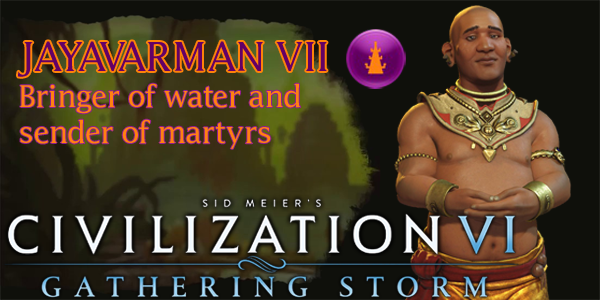
Civilization VI's third expansion, Gathering Storm recently released and has added a handful of new civilizations and leaders. I am hoping to write a strategy for each of them, but I also want to continue to write guides for the civilizations that were already in the game. I put up a poll on my Patreon page for my patrons to vote on which civ(s) they would like to see. The three top vote-getters (from all the three people who voted) were Khmer, Aztec, and Norway. It's been a while since I've done a strategy for a religion-oriented civ, so I thought I'd do a strategy for Jayavarman VII of the Khmer. The Khmer were present as a playable civilization in Civilization IV's Beyond the Sword expansion, but they were not present in Civilization V. They appeared as a DLC civ prior to Rise & Fall's release, but this strategy should work for players of the new Gathering Storm expansion as well.
The city of Angkor, the capital of the Angkor Empire (also called the Khmer Empire), is believed to be the largest pre-industrial urban center in the world, stretching for roughly 400 square miles and housing roughly 0.1% of the entire global population at its zenith. This empire controlled most of mainland southeast Asia from the ninth century CE to the 15th century CE, reaching its zenith between the 11th and 13th centuries. Many impressive ruins still stand in the site of Angkor, and many have been restored by local archaeological organizations and UNESCO, including the impressive Angkor Wat, the largest single religious monument in the world. Satellite imagery has also revealed an intricate network of irrigation channels which were likely used to manage the regions unpredictable monsoons, as well as to support the population.

Around 1150 CE, the kingdom of Angkor was invaded by the neighboring Cham empires, who succeeded at toppling the capital. General Mahaparamasaugata (believed to already be over the age of 60) lead a successful campaign to push the Cham out of the Khmer capital, and he ascended to the throne in order to continue the war and conquer much of the Champa territory. He relocated the capital to Angkor Thom, where large monuments were constructed in his honor, including the temple of Bayon. He went on to re-unify the empire, building a network of roads connecting every major town, complete with rest-houses every 9 miles and hospitals for travelers. He reigned successfully until his death at the impressively-ripe old age 97 or 98, and is regarded as the last great king of Cambodia. He was posthumously re-named Jayavarman VII, after a line of Cambodia's greatest kings.
DISCLAIMER:
Civilization VI is still a "living game". Strategies for the game (and for specific leaders and civs) may change as Firaxis applies balance patches, introduces new features, or expands the game through further DLC or expansion packs, or as the Civ community discovers new strategies or exploits. As such, the following strategy guide may change from time to time. I will try to keep it up-to-date, and will make notations whenever changes are made. I'll also post links in the official 2K forums and CivFanatics, where I'll also report any changes made. If possible and practical, I will try to retain the original content of the strategy for posterity.
I welcome any feedback or suggestions that readers wish to offer. Feel free to post on the linked forums, or by posting a comment at the bottom of the page.
This guide is up to date as of the release of the Gathering Storm expansion (ver. 1.0.0.314) (Antarctic Late Summer Patch, April 2019)
Khmer is a strong religious civ who gets extra food from Holy Sites, and extra faith from Aqueducts, as well as other bonuses to food and amenity. It can build and support large populations in its cities, and gets relics from its missionaries and apostles much more frequently, which can contribute to a culture victory.
... [More]
3a7fbd1d-fdc3-49c8-a0b2-e222656249c4|2|3.5
Tags:Sid Meier's Civilization, Civilization VI, Civilization VI: Gathering Storm, Khmer, Jayavarman VII, Grand Barays, monasteries of the king, domrey, prasat, temple, aqueduct, farm, food, holy site, missionary, apostle, religion, relic, culture, tourism, DLC, Patreon, unique building, unique siege unit
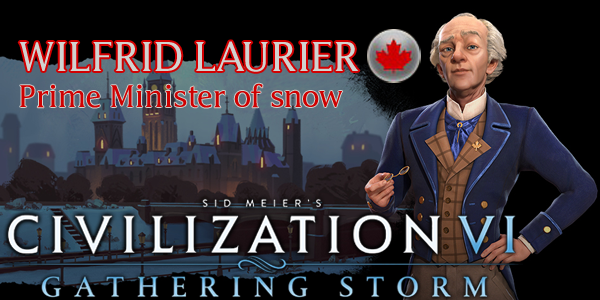
Civilization VI's second expansion, Gathering Storm recently released and has added a handful of new civilizations and leaders. I am hoping to write a strategy for each of them, but I want to start with the civilizations and leaders who are completely new to the franchise.
One of these new civs represents a sort-of "farewell" present to the founder and former lead-host of the PolyCast podcast, Dan Q, who stepped down from the podcast at the end of 2018 in order to spend more time with his new family. However, he'll still be playing Civ, and for the first time in the franchise's history, Dan gets to play as his home and native land of Canada. It's too bad he's not on PolyCast anymore to tell us about how great Wilfrid Laurier of Canada is, eh?

On a more serious note: thank you, Dan for over a decade of faithful service and dedication to the Civilization community. And on a more personal note, thank you for inviting me to join the regular panel on PolyCast. You gave me a voice within this community that I did not think I would ever be able to reach. We'll miss you, Dan, and we hope to talk to you again as a guest host many times in the future. Best wishes to you and your new wife in your new life together. May your lives together be forever in a Golden Age!
This guide is dedicated to you, Dan. Now let's talk about Canada in Civilization VI!

The first European colony in North America is widely accepted to be a Norse encampment in Newfoundland, which was abandoned within a few years of settlement. It wasn't until the 16th century that large-scale colonization began -- mostly by French and British colonists. In 1763, France ceded most of its North American colonies to the British following years of on-again-off-again warfare. The Confederation of Canada was formed over a hundred years later, but remained loyal to the British crown until the Canada Act of 1982. Despite being a formally independent nation, Canada still maintains the British monarch (currently Queen Elizabeth II) as its official head of state. Because many of the founding cities were French colonies, Canada is an officially bilingual country, with both English and French being its official languages, and it is now one of the most multi-cultural nations in the world due to frequent large-scale immigration from other parts of the world. Canadian interactions with indigenous peoples were generally less violent than with neighboring United States' interactions with natives. However, the expansion of Canadian territory still required the forced relocation or assimilation of somewhere between 200,000 and 2 million indigenous peoples, including the Inuit, Métis, the Cree, and several dozen other tribes.
Canada's first French-speaking prime minister was Sir Henri Charles Wilfrid Laurier. Laurier was part of Canada's Liberal party, advocating for decentralized federalism and staunchly defending individual personal liberty. Despite wishing for Canada to remain an autonomous nation loyal to the British Empire, he would go on to oppose British conscription of Canadian citizens in World War I, which would become a polarizing issue in the early 20th century. He gained a reputation as a bright and cheerful leader who always followed the "sunny ways", and has become one of the most beloved prime minsters in Canadian history.
DISCLAIMER:
Civilization VI is still a "living game". Strategies for the game (and for specific leaders and civs) may change as Firaxis applies balance patches, introduces new features, or expands the game through further DLC or expansion packs, or as the Civ community discovers new strategies or exploits. As such, the following strategy guide may change from time to time. I will try to keep it up-to-date, and will make notations whenever changes are made. I'll also post links in the official 2K forums and CivFanatics, where I'll also report any changes made. If possible and practical, I will try to retain the original content of the strategy for posterity.
I welcome any feedback or suggestions that readers wish to offer. Feel free to post on the linked forums, or by posting a comment at the bottom of the page.
This guide is up to date as of the release of the Gathering Storm expansion (ver. 1.0.0.290)
Canda is a prime contender for a turtle strategy, as it cannot surprise declare on other civs, or be surprise declared on. They also specialize in settling in otherwise-inhospitable tundra.
... [More]
504f5955-2cb6-4f67-90d0-584dee7a227e|0|.0
Tags:Sid Meier's Civilization, Civilization VI, Civilization VI: Gathering Storm, Canada, Wilfrid Laurier, four faces of peace, the last best west, tundra, hockey, hockey rink, farm, mountie, national park, tourism, culture, world congress, diplomatic favor, unique improvement, unique mounted unit
|

| 12 | | | | | | | 60 | | 11 | | | | | | | 55 | | 10 | | | | | | | 50 | | 09 | | | | | | | 45 | | 08 | | | | | | | 40 | | 07 | | | | | | | 35 | | 06 | | | | | | | 30 | | 05 | | | | | | | 25 | | 04 | | | | | | | 20 | | 03 | | | | | | | 15 | | 02 | | | | | | | 10 | | 01 | | | | | | | 05 |
|